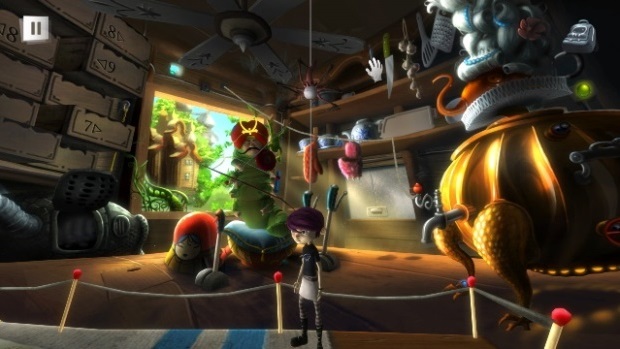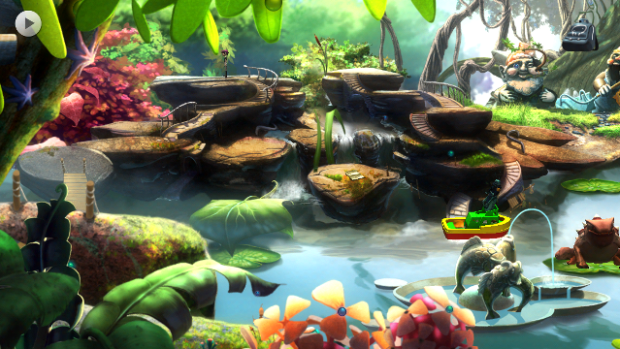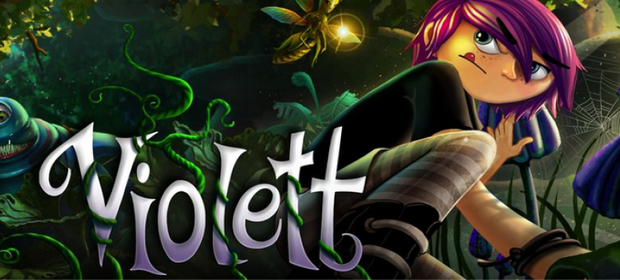Steam Greenlight has already helped a good number of games make their way onto the Steam marketplace, games which may otherwise have found it difficult to carve out a niche for themselves. The community-driven scheme lets gamers choose which titles in development they would like to see make it to retail via Steam, and that should in theory result in there being more of the games that people want, where they want them.
Violett is one of those games. An old-fashioned point and click adventure, Violett takes liberal dollops of inspiration from the the work of Lewis Carroll (Alice in Wonderland, for example) in a story also concerning a curious young girl. Violett’s parents argue a lot, and upon moving to a creepy old house in the countryside, this only gets worse. Finding her room to be the only place for solitude, Violett whiles away the days there – that is until she spots a strange gleaming light coming from a mouse hole in her room. Upon sticking her hand into the hole she finds a mysterious amulet, which promptly whisks her off to another world full of danger and confusion.

The other world is a mixture of miniaturised elements from her own home, and a selection of weird creatures and contraptions. The Alice in Wonderland influences are clear to see throughout, what with talking Caterpillars, oversize Teapots and an Evil Queen to defeat – it is obvious what feel the developers wished to evoke. There are other recognisable elements, such as a room of distorted staircases in an M.C. Escher style, among others. The end result is a disorientating mix of unusual locations and items, which creates an uneasy feeling and a sense of foreboding.
Unfortunately, other than the exposition at the start of the gam, which you have to interpret yourself as there are no voices throughout the game (save for some Sim-like speech here and there), there is no other story progression or background to be gleaned. In fact, the only motivation for the whole game is the assumption of the player that Violett wants to go back home. There is no development of any of the characters – be they the protagonist or any of the enemies or other creatures that she encounters. This doesn’t help draw the player in at all, and each of the different scenes end up being a disparate collection of puzzles rather than a coherent adventure.

The graphics are more interesting however, with the 2.5D style of the game working quite well for the material. All characters are rendered as 3D models, whereas the backgrounds are all hand drawn. Although it doesn’t sound like a great mix, the style of the two meshes quite well, and the models certainly don’t look out of place against the backdrops. The visual style complements the subject matter, and is both otherworldly and creepy at the same time. It manages to possess that edge of menace that Lewis Carroll stories also show, while also maintaining a magical charm. The music is suitably unsettling and helps add to the atmosphere, but the tracks are all quite short and if you get stuck in one room they will loop infinitely and can become grating.
The gameplay is very basic point and click, but is let down by a series of poor design choices. There is a good variety of inventory-based puzzles, mazes and physical puzzles such as sliding tiles, which keeps each screen fresh. One particularly fun puzzle is a chain reaction that must be set-up correctly. There are some inventive ideas, but the whole thing just doesn’t inter-relate greatly or sit well together. In the first scene, Violett comes into contact with a Fairy, from whom she gains Telekinetic powers. This means that you don’t have to walk around every scene in order to grab or use objects, which seems like a design choice made purely to simplify the game and reduce the amount of animations that have to be performed, and could be considered a somewhat lazy choice.

When using any items in the environment an interaction glow will appear, but if you wish to use inventory items, there is no indication where they can or cannot be used, and no feedback if you attempt to use something that doesn’t work. The game claims to have a hint system but all it provides is a cursor telling you how to move your mouse over selected items which need to be wiggled – but this happens so infrequently that it is no real help at all.
The final nail in the coffin, as it were, is that Violett asks you to almost constantly back-track from one side of the game world to the other. The M.C. Escher staircase room acts as a central hub of sorts, from which most other scenes are accessible. This means if you pick up an item in one scene, you must work your way through the staircase maze across to another room. This gets very tedious after just a few tries and makes even simple navigation through the game more painful than it needs to be.

VERDICT: An intriguing premise and interesting art style aren’t enough to drag Violett up to the level of other more accomplished point and click adventures. The design choices – that may or may not have been made in an attempt to reduce HUD intrusion and disconnect within the game – simply lead to too much irritation and this scuppers all of the good groundwork which has been laid by the intelligent puzzle design. Players are bound to get some fun out of solving the challenging conundrums in Violett, which is a refreshing change from the often far too easy puzzlers we see nowadays, but it simply isn’t enough to strongly recommend a title that frustrates more often than not.

DECENT. A 6/10 indicates that, while this game could be much better, it still has a fair amount to offer the player. It might be an interesting title sabotaged by its own ambition, or a game denied greater praise by some questionable design choices. Don’t avoid it outright, but approach it with caution.
Review code provided by publisher.







